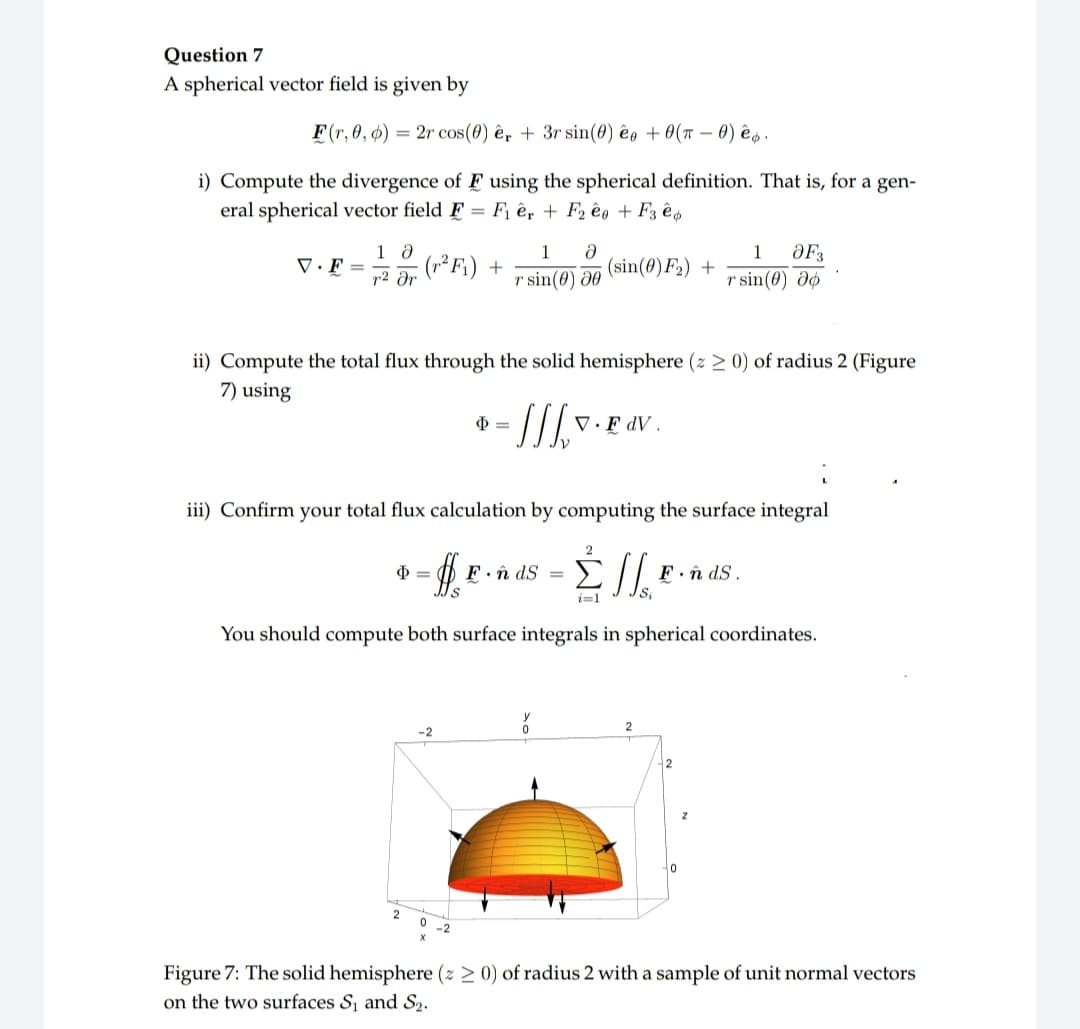A spherical vector field is given by F(r,0,0)=2r cos(0) êr + 3r sin(0) ê +0(π- 0) ê. i) Compute the divergence of F using the spherical definition. That is, for a gen- eral spherical vector field F = F₁ êr + F₂ eo + F3 ê V.F = 10 r² Ər (r²F₁) + 1 ə r sin(0) 00 (sin(0) F₂) + $= ii) Compute the total flux through the solid hemisphere (z > 0) of radius 2 (Figure 7) using = /[[, V. Edv. V.FdV. 1 аF3 r sin(0) do
A spherical vector field is given by F(r,0,0)=2r cos(0) êr + 3r sin(0) ê +0(π- 0) ê. i) Compute the divergence of F using the spherical definition. That is, for a gen- eral spherical vector field F = F₁ êr + F₂ eo + F3 ê V.F = 10 r² Ər (r²F₁) + 1 ə r sin(0) 00 (sin(0) F₂) + $= ii) Compute the total flux through the solid hemisphere (z > 0) of radius 2 (Figure 7) using = /[[, V. Edv. V.FdV. 1 аF3 r sin(0) do
Algebra & Trigonometry with Analytic Geometry
13th Edition
ISBN:9781133382119
Author:Swokowski
Publisher:Swokowski
Chapter8: Applications Of Trigonometry
Section8.3: Vectors
Problem 60E
Related questions
Question
Q7 Part I and II needed to be solved in 30 minutes

Transcribed Image Text:Question 7
A spherical vector field is given by
F(r, 0, 0) 2r cos(0) ê, + 3r sin(0) eo + 0(T0) êø.
=
i) Compute the divergence of F using the spherical definition. That is, for a gen-
eral spherical vector field F = F₁ êr + F₂ eo + F3 ê
1 ə
r² Ər
V.F= (r²F₁) +
$=
ii) Compute the total flux through the solid hemisphere (z ≥ 0) of radius 2 (Figure
7) using
2
1 Ә
r sin(0) 20
$=
-2
(sin(0) F2) +
•///.V.F
iii) Confirm your total flux calculation by computing the surface integral
2
· Elle
Σ
i=1
#fr. ñ ds
-2
V.FdV.
1 OF3
r sin(0) do
You should compute both surface integrals in spherical coordinates.
F. ds.
0
Figure 7: The solid hemisphere (z ≥ 0) of radius 2 with a sample of unit normal vectors
on the two surfaces S₁ and S₂.
Expert Solution
This question has been solved!
Explore an expertly crafted, step-by-step solution for a thorough understanding of key concepts.
Step by step
Solved in 6 steps

Recommended textbooks for you

Algebra & Trigonometry with Analytic Geometry
Algebra
ISBN:
9781133382119
Author:
Swokowski
Publisher:
Cengage

Algebra and Trigonometry (MindTap Course List)
Algebra
ISBN:
9781305071742
Author:
James Stewart, Lothar Redlin, Saleem Watson
Publisher:
Cengage Learning

Algebra & Trigonometry with Analytic Geometry
Algebra
ISBN:
9781133382119
Author:
Swokowski
Publisher:
Cengage

Algebra and Trigonometry (MindTap Course List)
Algebra
ISBN:
9781305071742
Author:
James Stewart, Lothar Redlin, Saleem Watson
Publisher:
Cengage Learning